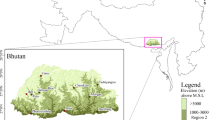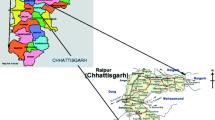Abstract
Long-term trend analysis of meteorological variables is required for implementing any hydrological model or water resources management model to a basin. Spatio-temporal variations in precipitation and temperature of a basin are helpful for meteorologists, agriculturists and policymakers to take appropriate decisions. This study performs long-term trend analysis for gridded precipitation (1901–2019) and temperature (1951–2019) datasets of 0.25º × 0.25º resolution in the Munneru river basin, India using five different trend tests for annual, seasonal and monthly time steps in sub-basin wise. An increasing trend is observed in annual precipitation in the first sub-basin (S1) at 8.6 mm/decade and in the third sub-basin (S3) at 11.6 mm/decade. An increasing trend is observed for both annual average maximum and minimum temperature at a rate of 1.5ºC and 0.06ºC per decade for the basin, respectively. Twenty different climate extreme indices are calculated using daily data of precipitation and temperature. Increasing trend is observed for PCPTOT, R20mm, RX5DAY, R95PTOT, SDII, TX90P, TXX and WSDI indices. Decreasing trend is observed for CWD, CSDI, TN10P and TX10P at particular grid points. Results from this study are useful to understand the climate variability and its impact on water resources in the future periods and hydrological assessment in the basin.
Research Highlights
-
In this study detailed long-term trend analysis was carried out for precipitation and temperature using four different trend tests and ITA was used to check, whether the trend is monotonic or non-monotonic.
-
The increasing trends in precipitation and climate extremes in this region require careful extension of this study into evaluation of extreme hydrologic–hydraulic flow regimes.
-
Results from this study are used to address the cropping pattern, irrigation, water supply and demand-related issues in this basin.















Similar content being viewed by others
References
Adarsh S and Janga Reddy M 2015 Trend analysis of rainfall in four meteorological subdivisions of southern India using nonparametric methods and discrete wavelet transforms; Int. J. Climatol. 35 1107–1124, https://doi.org/10.1002/joc.4042.
Bisht D S, Chatterjee C, Raghuwanshi N S and Sridhar V 2018 Spatio-temporal trends of rainfall across Indian river basins; Theor. Appl. Climatol. 132 419–436, https://doi.org/10.1007/s00704-017-2095-8.
Caloiero T, Coscarelli R and Ferrari E 2017 Analysis of rainfall trend in southern Italy through the application of the ITA technique; European Water 59 199–206.
Deshpande N R, Kothawale D R and Kulkarni A 2016 Changes in climate extremes over major river basins of India; Int. J. Climatol., https://doi.org/10.1002/joc.4651.
Dubey S K and Sharma D 2018 Spatio-temporal trends and projections of climate indices in the Banas River Basin, India; Environ. Process. 5(4) 743–768, https://doi.org/10.1007/s40710-018-0332-5.
Eswar S B, Venkata R K, Loukika K N and Sridhar V 2022 Spatio-temporal analysis of climatic variables in the Munneru River Basin, India, using NEX-GDDP data and the REA approach; Sustainability 14 1715, https://doi.org/10.3390/su14031715.
Gajbhiye S, Meshram C, Mirabbasi R and Sharma S K 2016 Trend analysis of rainfall time series for Sindh river basin in India; Theor. Appl. Climatol. 125(3) 593–608.
Gocic M and Trajkovic S 2013 Analysis of changes in meteorological variables using Mann–Kendall and Sen’s slope estimator statistical tests in Serbia; Global Planet. Change 100 172–182, https://doi.org/10.1016/j.gloplacha.2012.10.014.
Hamed K H 2009 Enhancing the effectiveness of prewhitening in trend analysis of hydrologic data; J. Hydrol. 368 143–155, https://doi.org/10.1016/j.jhydrol.2009.01.040.
Harshvardhan P L, Nayak P C and Kumar S 2020 Spatio-temporal rainfall variability and trend analysis for Krishna River Basin in India; Indian J. Ecol. 47 54–59.
IMD 2021 Climate Data Service Portal; https://cdsp.imdpune.gov.in/home_gridded_data.php.
Jaswal A K, Rao P C S and Singh V 2015 Climatology and trends of summer high temperature days in India during 1969–2013; J. Earth Syst. Sci. 124 1–15.
Kendall M G 1962 Rank Correlation Methods; Hafner Publishing Company, New York.
Kisi O 2015 An innovative method for trend analysis of monthly pan evaporations; J. Hydrol. 527 1123–1129.
Kumar S, Merwade V, Kam J and Thurner K 2009 Streamflow trends in Indiana: Effects of long term persistence, precipitation and subsurface drains; J. Hydrol. 374(1–2) 171–183, https://doi.org/10.1016/j.jhydrol.2009.06.012.
Loukika K N, Venkata R K and Sridhar V 2021 Analysis of land use and land cover using machine learning algorithms on Google Earth Engine for Munneru River Basin, India; Sustainability 13 13758.
Mann H B 1945 Non-parametric tests against trend; Econmetrica 13 245–259.
Naumann G, Llano M P and Vargas W M 2010 Climatology of the annual maximum daily precipitation in the La Plata Basin; Int. J. Climatol. 32 247–260.
Roy S S and Balling R C 2004 Trends in extreme daily precipitation indices in India; Int. J. Climatol. 24(4) 457–466, https://doi.org/10.1002/joc.995.
Şen Z 2012 An innovative trend analysis methodology; J. Hydrol. Eng. 17 1042–1046.
Seong C and Sridhar V 2017 Hydroclimatic variability and change in the Chesapeake Bay watershed; J. Water Clim. Change 8 254–273, https://doi.org/10.2166/wcc.2016.008.
Singh D, Gupta R D and Jain S K 2015 Study of daily extreme temperature indices over Sutlej Basin NW Himalayan region India; Global Nest J. 17(2) 301–311.
Sonali P and Nagesh Kumar D 2013 Review of trend detection methods and their application to detect temperature changes in India; J. Hydrol. 476 212–227, https://doi.org/10.1016/j.jhydrol.2012.10.034.
Sridhar V, Jin X and Jaksa W T A 2013 Explaining the hydroclimatic variability and change in the Salmon River basin; Clim. Dyn. 40 1921–1937, https://doi.org/10.1007/s00382-012-1467-0.
Storch H V and Hereon H 1995 Analysis of climate variability; Analysis of Climate Variability – Applications of Statistical techniques, pp. 10–26, https://doi.org/10.1007/978-3-662-03167-4.
Tosunoglu F and Kisi O 2017 Trend analysis of maximum hydrologic drought variables using Mann–Kendall and Şen’s innovative trend method; River Res. Appl. 33 597–610.
Venkat R G, Venkata R K, Srinivasan R, Sridhar V, Umamahesh N V and Pratap D 2020 Spatio-temporal analysis of rainfall extremes in the flood-prone Nagavali and Vamsadhara Basins in eastern India; Weather Clim. Extremes, https://doi.org/10.1016/j.wace.2020.100265.
Weldegerima T M, Zeleke T T, Birhanu B S, Zaitchik B F and Fetene Z A 2018 Analysis of rainfall trends and its relationship with SST signals in the lake tana basin, Ethiopia; Adv. Meteorol., https://doi.org/10.1155/2018/5869010.
Zhang X, Yang F and Canada E 2004 RClimDex (1.0) User Manual, pp. 1–23.
Acknowledgements
Authors sincerely thank India Meteorological Department (IMD) for sharing the observed meteorological data and the National Remote Sensing Center (NRSC) for LULC map of the study area. This work is funded by the Department of Science and Technology (DST), Government of India, under BRICS – DST project with Grant No: DST/IMRCD/BRICS/PilotCall2/IWMM-BIS/2018 (G).
Author information
Authors and Affiliations
Contributions
Eswar Sai Buri: Data curation, formal analysis, investigation, methodology, software, visualization, writing – original draft, review and editing. K Venkata Reddy: Conceptualization, data curation, funding acquisition, investigation, methodology, project administration, resources, software, validation, visualization, writing – original draft, review and editing. K N Loukika: Data curation, formal analysis, investigation, methodology, software, visualization, writing – original draft, review and editing.
Corresponding author
Additional information
Communicated by T Narayana Rao
Rights and permissions
About this article
Cite this article
Buri, E.S., Keesara, V.R. & Loukika, K.N. Long-term trend analysis of observed gridded precipitation and temperature data over Munneru River basin, India. J Earth Syst Sci 131, 115 (2022). https://doi.org/10.1007/s12040-022-01864-7
Received:
Revised:
Accepted:
Published:
DOI: https://doi.org/10.1007/s12040-022-01864-7




